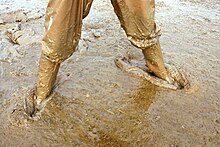Silt
Silt is a fine-grained sediment that can form in any body of water. Silts with a high proportion of sand are called silts . Unsolidified silt deposits, especially in the cloudiness zones of estuaries, are called fluid mud . Silt rocks belong to the biopelites .
Examples of today's silt formation can also be mud flats and mangrove silts , examples of fossil silts are flyschtone and wavy limestone .
The shipping and sedimentology causes problems Schlick, because he due to the low impedance differences to water sonar signals not sufficiently reflected the position of the solid substrate thus often is difficult to determine.
A Kreier ("Schlickrutscher") is used by a person and their cargo to move about in the silt.
Indicates some ships or was there a Schlickegge to Schlick, stirring up to let him carry away with the flow and about to achieve a harbor entrance a depression. Today, a water injection device is more commonly used for this purpose . See e.g. B. Elbe deepening .
Mud packs and mud tub baths are classic spa treatments in the field of balneology and spa medicine.
Web links
Individual evidence
- ↑ a b c H. Murawski, W. Meyer: Geological dictionary. 11th edition. Spectrum Academic Publishing House, 2004, ISBN 3-8274-1445-8 .
- ↑ a b K. Schrottke, M. Becker, A. Bartholomä, BW, Flemming, Hebbeln, D .: Fluid mud dynamics in the Weser estuary turbidity zone tracked by high-resolution side-scan sonar and parametric sub-bottom profiler. In: Geo-Marine Letters. 26 (3), 2006, pp. 185-198.
